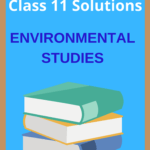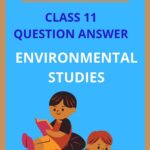Class 11 Environment Chapter 2 Ecological Concepts The answer to each chapter is provided in the list so that you can easily browse through different chapters Assam Board HS 1st Year Environmental Studies Chapter 2 Ecological Concepts Question Answer.
Class 11 Environment Chapter 2 Ecological Concepts
Also, you can read the SCERT book online in these sections Solutions by Expert Teachers as per SCERT (CBSE) Book guidelines. These solutions are part of SCERT All Subject Solutions. Here we have given Assam Board Class 11 Environment Chapter 2 Ecological Concepts Notes for All Subjects, You can practice these here.
Ecological Concepts
UNIT – 2
ENVIRONMENTAL STUDIES
Textual Questions and Answers
1. Define the term ecology.
Ans: An aspect of biology that deals with the interrelationship between biotic and abiotic components as well as the relationships among the individuals of the biotic component is called ecology.
2. What do you mean by ecosystem?
Ans: An ecosystem is a community of organisms involved in a dynamic network of biological, chemical and physical interactions between themselves and with the nonliving components. Such interactions sustain the system and allow it to respond to changing conditions. Thus, an ecosystem includes the biological components, the nonliving components (physical environment) and their interactions. The Kaziranga ecosystem will thus include the various life forms found in the park. (the community) and also the non-living components of the park like the soil, rocks, water etc. and even the solar energy that is captured by the plants Ecosystem is the main active unit of ecology.
3. Classify the ecosystems.
Ans: Ecosystem is two major types:
(a) Natural ecosystem.
(b) Artificial or man made ecosystem
(a) Natural ecosystem: It is again divided into
(i) Terrestrial ecosystem (for example-forest ecosystem, grassland ecosystem, desert ecosystem.) and
(ii) Aquatic ecosystem: It can be fresh water ecosystem and marine ecosystem. Fresh water ecosystem may be lotic (free flowing type, c.g. river) or lentic (standing type, eg ponds, lakes)
(b) Man made ecosystem: These ecosystems are created by man. For example-crop land ecosystem, fisheries etc.
4. What are lotic and lentic ecosystems? Give examples.
Ans: Lotic ecosystem: Lotic ecosystem or free ecosystem c.g. rivers, stems.
Lentic ecosystem: Lentic ecosystem or standing ecosystem e.g. ponds, lakes.
5. What are producers, consumers and decomposers?
Ans: Producers: Green plants which trap solar energy and convert it to potential chemical energy are called producers, Consumers: All animals and non-green plants which directly or indirectly depend upon the producers for energy are called consumers. They may be herbivores, carnivores, omnivores, detritivores.
Decomposers: They derive their nutrition by breaking down the complex organic molecules to simpler organic compounds and ultimately into inorganic nutrients. Various bacteria and fungi are decomposers.
6. Write briefly on structure and functions of an ecosystem.
Ans: The structure of an ecosystem:
(i) Biotic structure: The plants, animals and microorganisms present in an ecosystem form the biotic components. These are as follows-
(a) Producers: Green plants which trap solar energy and convert it to potential chemical energy are called producers.
(b) Consumers: All animals and non-green plants which directly or indirectly depend upon the producers for energy are called consumers. They may be herbivores, carnivores, omnivores, detritivores.
(c) Decomposers: They derive their nutrition by breaking down the complex organic molecules to simpler organic compounds and ultimately into inorganic nutrients, Various bacteria and fungi are decomposers.
(ii) Abiotic structure: The physical and chemical components of an ecosystem constitute its abiotic structure.
(a) Physical factors: The sunlight and shade, intensity of solar flux duration of sun hours, average temperature, maximum-minimum tempera ture, annual rainfall, wind, latitude and altitude etc. are some of the impor tant physical features which have a strong influence on the ecosystem.
(b) Chemical factors: Availability of major essential nutrients, like carbon, nitrogen, phosphorus, hydrogen, oxygen, level of toxic substances, salts causing salinity and various organic substances present in the soil or water largely influence the functioning of an ecosystem.
Function of an ecosystem: Ecosystems perform their functional attributes in a systematic way under natural conditions. They receive energy from the sun and pass it into the different components at different levels. The function of an ecosystem can only be considered as a whole, as every part of the ecosystem has a functional effect on another. The major functional characteristics of an ecosystem may be described in terms of food chain, food webs and trophic levels, energy flow, nutrients cycles etc.
7. What are food chain and food web?
Ans: Food chain: In an ecosystem, the sequential chain of eating and being eaten is called a food chain. The common examples of food chain are Grasses-cattle-tiger (the chain consists of three links)
Grasses-grasshopper-birds-hawks (the chain consists of four links) Phytoplankton-water fleas-small fish-tuna(the chain consists of three links)
Two types of food chain can be found in natural ecosystem. One type starts from green plants (autotrophs) constituting the first trophic level. the herbivores form the second trophic level and predators form the third trophic level. They are referred to as grazing food chain, The other type starts with debris detritus produced by green plants and is termed as detritus food chain. A food chain it always unidirectional.
Food Web: A number of food chains interwoven with one another give rise to a structure similar to the web pf a spider. These interlocking patterns formed by several food chains that are linked together are called food webs. So a food web is a network of food chains where different types of organisms are connected at different trophic levels, so that there are a number of options of eating and being eaten at each trophic level.

The two most important functions of the ecosystem i.e. energy flow and nutrient cycling take place through them.
8. What is trophic level?
Ans: Every organism in an ecosystem can be assigned a feeding level, referred to as the trophic level. The living organisms which derive energy from the same source are said to belong to the same trophic level. Thus green plants would be grouped in the first trophic level (producers), herbivores the second trophic level (Primary consumers), carnivores in the third (secondary consumers) and so on.
9. What do you mean by ecological pyramids? Name the different types of ecological pyramids.
Ans: An ecological pyramid is a graphical representation of an ecological parameter, like number of biomass or accumulated energy at different trophic levels in a food chain in an ecosystem. Ecological pyramids are of three types-
(i) Pyramid of numbers: It is the graphic representation showing the arrangement of number of individuals (population size) of different trophic levels in a food chain in an ecosystem.
(ii) Pyramid of biomass: The total amount of living or organic mat ter in an ecosystem at any time is called biomass. Pyramid of biomass is a graphic representation of biomass present per unit area in different trophic levels.
(iii) Pyramid of energy: It is a graphic representation of amount of energy trapped per unit time and area in different trophic levels of a food chain.

10. Mention the main characteristics of food chain and food web.
Ans: The main characteristics of food chain and food web are:
(i) Food chains and food webs paly a very significant role in the ecosystem because the two most important functions of energy flow and nutrients cycling take place through them.
(ii) The food chains also help in maintaining and regulating the popula tion size of different animals and thus, help maintain the ecological bal ance.
(iii) Food chains show a unique property of biological magnification of some chemicals, there are several pesticides, heavy metals and other chemicals which are non biodegradable in nature. Such chemicals are not decomposed by microorganisms and they keep on passing from one trophic level to another. At each successive trophic level, they keep one increasing in concentration. This phenomenon is known as biomagnification or biological magnification.
VERY SHORT TYPES QUESTION & ANSWER MARKS:
1. Name two types of habitats on our planet.
Ans: Terrestrial and Aquatic habitat.
2. What is biosphere?
Ans: The zone consisting of land, water and air where life exists is called a biosphere.
3. What is the percentage of hydrosphere on the earth surface?
Ans: Hydrosphere covers about 73% area of the earth surface.
4. What is the meaning of litho?
Ans: The meaning of litho is stony.
5. What is stratopause?
Ans: The upper layer of the stratosphere is known as stratopause.
6. What is the importance of the troposphere?
Ans: Troposphere is the most important zone of the atmosphere. Cloud formation, thundering, lightning etc. take place in this zone.
7. Define ecology.
Ans: An aspect of biology that deals with the interrelationship between biotic and abiotic components as well as the relationships among the individuals of the biotic component is called ecology.
8. What is population ecology and gynecology?
Ans: Study of population and their interactions is termed as population ecology while the study of population of a single species is called gynecology.
9. Into how many types can ecology be divided? Name them.
Ans: Ecology can be divided into two types.
They are:
(i) Autecology
(ii) Synecology.
10. Define ecological niche.
Ans: An ecological niche is the unique complex of factors which characterizes the environment of any given population.
11. What is the full form of IBP?
Ans: The International Biological Programme.
12. Define ecosystem?
Ans: Any unit in which there is interaction between organisms and their physico-chemical environment and between organisms and materials is called an ecosystem.
13. What is terrestrial and aquatic ecosystems.
Ans: The desert, grassland, forest, crop-fields and mountains represent terrestrial ecosystem, whereas ponds, lakes, rivers, seas and aquarium represent aquatic ecosystems.
14. What are terrestrial and aquatic ecosystems.
Ans: The desert, grassland, forest, crop-fields and mountains represent terrestrial ecosystems, whereas ponds, lakes, rivers, seas and aquarium represent aquatic ecosystems.
15. Give examples of some man-made ecosystems.
Ans: Crop-fields, gardens, aquarium etc.
16. What is phytoplankton?
Ans: The Autotrophs in deep water are microscopic floating plant called phyto-plankton.
17. Define food chain.
Ans: The sequence of eating and being eaten in an ecosystem is known as food chain.
18. What are the components of an environment?
Ans: The environment consists of non-living or abiotic components and a living biological community or biotic components.
19. What is the meaning of ‘biosphere”?
Ans: The entire inhabited part of the earth and its atmosphere including the living and the non-living components form the biosphere.
20. What are the primary constituents of the biosphere?
Ans: The primary constituents of the biosphere are:
(i) The Hydrosphere.
(i) The Lithosphere
(iii) The Atmosphere.

Hi, I’m Dev Kirtonia, Founder & CEO of Dev Library. A website that provides all SCERT, NCERT 3 to 12, and BA, B.com, B.Sc, and Computer Science with Post Graduate Notes & Suggestions, Novel, eBooks, Biography, Quotes, Study Materials, and more.






Pdf download
Thank you so much